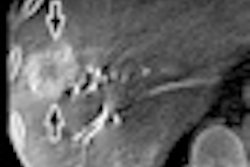
CHICAGO - A new flagship 320-detector-row CT scanner, a price drop for its 1.5-telsa MRI scanner, and new technologies in ultrasound and wireless digital x-ray are among the highlights in the RSNA 2012 booth of Toshiba America Medical Systems.
CT
At the top of Toshiba's RSNA agenda is Aquilion One Vision, the first new 320-detector-row scanner since the company launched the initial Aquilion One system in 2007. The new model includes a faster gantry rotation speed and more powerful x-ray generator to give clinicians the ability to perform cardiac imaging of patients with rapid heart rates in a single gantry rotation.
Toshiba's goal in designing Aquilion One Vision was to develop a scanner that enables the wide-coverage concept of Aquilion One (16 cm in a single rotation) to be used in a broader range of patients, such as the obese or those with high heart rates in the emergency department (ED) setting.
Aquilion One Vision sports a rotation speed of 275 msec, and its x-ray generator has a maximum power of 100 kW.
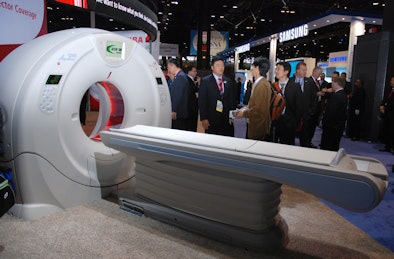 |
| Toshiba's Aquilion One Vision CT scanner. |
The new scanner's aperture has also been widened, to 78 cm from 72 cm on the older Aquilion One, and the scanner's couch now supports patients weighing up to 661 lb. The wider aperture is key to scanning obese patients, as many might not fit into the smaller aperture.
In other new features, Aquilion One Vision has a detector design that is 20% more efficient in converting photos to light, which reduces "afterglow" and speeds signal transmission. The scanner's reconstruction engine now reconstructs at up to 50 frames per second.
Toshiba sees Aquilion One Vision as being used routinely in the ED to triage stroke patients more quickly, or to perform CT cardiac perfusion instead of SPECT. One of the scanners has been installed at the U.S. National Institutes of Health, while several others are in operation in Asia. Regular shipments are scheduled to begin in January. The older Aquilion One will remain in the company's product line.
In other CT news, Toshiba is demonstrating the migration of its adaptive iterative dose reduction (AIDR) 3D algorithm across the firm's CT product line with its VeloCT upgrade. AIDR 3D can now be found on 64-slice and 32-slice systems. The company will also make its high-resolution detector, capable of 500-micron resolution, available across the product family.
Toshiba is also highlighting its Protect program, in which Toshiba personnel will visit a site, analyze its radiation dose levels, and work with the facility to reduce dose to the site's targeted levels as part of a three-year plan. Kaleida Health in Buffalo, NY, is the first site in the program.
Meanwhile, InstaView is a revised version of Toshiba's real-time image reconstruction protocol, with 5-mm reconstruction. The protocol is now able to save images for review. Also, iterative reconstruction has been added to Toshiba's body perfusion protocol to enable lower radiation doses to be used in perfusion studies. And in the company's Vital Images business, myocardial analysis has been added to the Vitrea workstation.
MRI
The big news in MRI at Toshiba's booth is a new price point for the company's 8-channel, 1.5-tesla Vantage Titan scanner, which the company claims is "never before seen in the industry" for a wide-bore, full-field-of-view scanner.
The scanner includes Toshiba's standard configuration and coil suite, along with the vendor's Pianissimo noise reduction technology, height-adjustable patient table, and wide bore, as well as a brand-new user interface.
The company has rolled out a new family of integrated coils called Octave, which occupy a price point below the vendor's Atlas coils on the 1.5-tesla Titan scanners. The Octave family includes a spine coil with 75 cm of coverage; the coils come in 8- and 16-channel configurations.
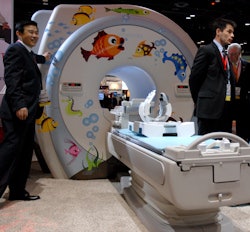 Toshiba's 3-tesla Titan MRI scanner.
Toshiba's 3-tesla Titan MRI scanner.
Toshiba is also talking up its 16-element flex coils, which are designed for orthopedic imaging but can be combined with a spine coil for a wide-bore field-of-view for all types of imaging. Toshiba will also demonstrate a special arrangement of the coils in a pediatric scan apparatus for imaging children -- the configuration is designed to eliminate the lower image quality that results when adult coils are used in children.
The coils are compatible with Toshiba's Speeder technology and are available in three sizes, although the small coil is still a work-in-progress.
Toshiba is also showing a patient transfer gurney designed to make it easier to handle difficult-to-move patients. The gurney is lightweight and rated up to 550 lb; patients are prepared for the study in advance and then placed in a tray on the gurney, which is wheeled up to dock with the MRI scanner's patient table. The table lifts the tray and moves patient into the magnet bore; after the procedure, the tray is placed back on the gurney and the patient can be wheeled out of the suite.
The gurney will be available as an option on Toshiba's 3-tesla Titan scanner. The flexible coils will also be on the 3-tesla scanner, but they are currently works-in-progress and are approximately three months from being commercially shipped.
Also on the 3-tesla Titan, Toshiba is showing high-amplitude gradients that go up to 45 mT/m from the current 30 mT/m rating. The slew rate of 203 mT/m/msec is still the same.
Other new developments in MRI include version 2 of the company's M-Power user interface, a new workflow tool for automated cardiac imaging called CardioLine, and a similar technology for brain imaging called NeuroLine. CardioLine is an option on Toshiba's MCardiac package, while NeuroLine is standard on the MNeuro package.
Ultrasound
Toshiba is showing new enhancements for its Aplio 500 and Aplio 300 scanners, which were launched as works-in-progress at the 2011 RSNA show and began shipping this year.
One such technology is Luminance 4D, a rendering and lighting technology that enables users to produce realistic faces of fetuses in utero.
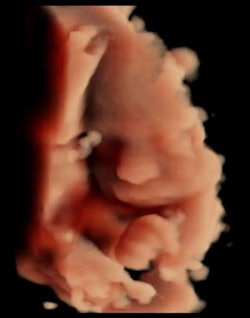 Toshiba's Luminance 4D feature. Image courtesy of Toshiba.
Toshiba's Luminance 4D feature. Image courtesy of Toshiba.
Toshiba will also demonstrate two new transducers as works-in-progress. PLT-1005BT is a high-frequency probe for small-parts imaging, such as breast, thyroid, and testes, with a wide 58-mm aperture. The other probe is PVT-781VT, an endocavity transducer for endovaginal and prostate imaging that is compatible with Toshiba's SmartFusion technology. Previously, SmartFusion was only available for abdominal imaging.
The company is also demonstrating the next generation of its QuickAssist scanning protocols for the Aplio 500 and Aplio 300 scanners. QuickAssist enables users to set up automated workflow that standardizes all ultrasound exams so that every sonographer follows the same protocol, creating consistency among exams in a department.
Toshiba is also showing its UltraExtend FX workstation, for offline review of ultrasound exams. The workstation is especially useful for flythrough studies, in which data are usually transferred from the scanner to the workstation for review. UltraExtend has received U.S. Food and Drug Administration (FDA) clearance and is available.
Finally, for a limited time, Toshiba is reviving an extended-warranty promotion first initiated with the launch of Aplio 500 and 300 in late 2011. Under the Reliance program, Aplio 500 will have a three-year warranty, while Aplio 300 is available with a two-year warranty. The offer will include one software upgrade per year during the warranty period.
X-ray
The hot news in the x-ray section of Toshiba's booth is the launch of RexPanel, Toshiba's entry into the wireless digital radiography (DR) arena.
RexPanel is particularly good for out-of-bucky work, according to the company, including situations such as imaging patients in wheelchairs or on gurneys, or for standing feet exams or cross-table work. The detector weighs in at 7.7 lb including the battery, and it has storage capacity for 10 images.
Like other Toshiba DR technology, RexPanel is based on cesium iodide panels, which the company believes offer higher detective quantum efficiency. The panel has FDA clearance, and Toshiba plans to begin commercial shipments after the RSNA meeting concludes.
RexPanel will be available initially in Toshiba's mixed radiography room configuration, with one wireless 14 x 17-inch RexPanel in the table and a 17 x 17-inch fixed panel in a wall stand.
Toshiba is also demonstrating a RexView image preview feature, as well as RexSpeed productivity enhancements for RadRex-i, including an autocentering feature that helps with detector centering. The feature includes automatic collimation to select the right collimation for the body part being imaged, with an autotracking function that enables the x-ray tube to track with the patient table.
Interventional x-ray
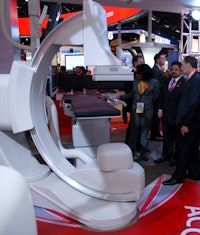 Toshiba's Infinix-i system.
Toshiba's Infinix-i system.
In the vascular and interventional realm, Toshiba is highlighting several branding initiatives relating to the mechanical design of its angiography systems.
Access Halo refers to the ability of Infinix-i to provide unobstructed head-in access to patients, with the C-arm positioned out of the way and the clinical team accessing the patient at the head end of the table. The feature provides better patient access, improved ergonomics, and more efficiency and safety.
Also, WorkRite is a mode that enables the system operator to have better line-of-sight visibility with system controls and display monitors. The system can be configured so the monitors move along with the operator, which Toshiba believes will improve workflow and reduce operator injuries.
The company is also promoting Spot Fluoro, a dose management tool for the Infinix-i system. The technique enables physicians to view an anatomical region using live fluoroscopy while viewing the surrounding area with the system's last image hold technique. This results in lower dose and a larger image display area.
Toshiba is also highlighting the Infinix VF-i biplane angiography system with dual 12 x 12-inch midsize flat-panel digital detectors.






